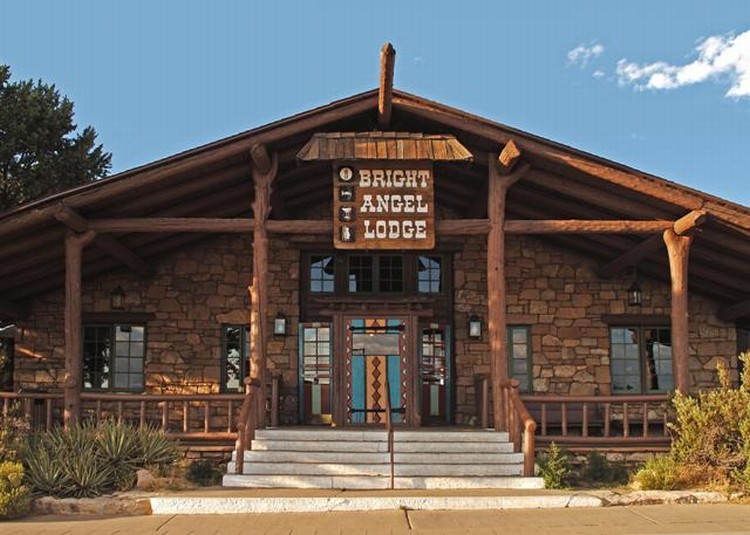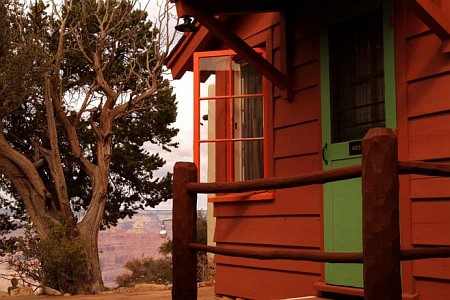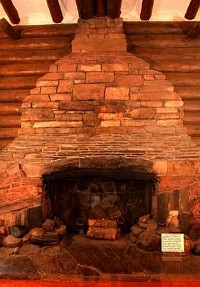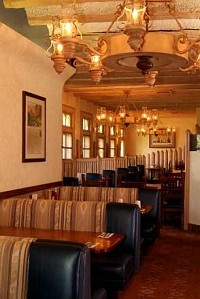Observations
The original Bright Angel Hotel was a relative latecomer to the Canyon Rim in 1896. It was in competition against the Grand View Hotel and a few other hastily built structures and camps. Partly because Bright Angel was the nicest of these tourist camps, but mainly because it was located at the northern terminus of the rail line, it was recognized as the best destination at the rim. Grand View Hotel had the distinct misfortune of being 16 miles away from the railroad, and relied on patrons willing to pay for an additional carriage ride. It closed "for renovations" right around the turn of the century.

above, fireplace scene in the original Bright Angel Hotel circa 1900
As quickly as it rose, it also declined. Following construction of the luxurious El Tovar in 1905, the 20-room Bright Angel Hotel became known mostly as an overflow annex, and the cabins and new cabin tents were regarded as lodging for "common folk" or "the working man." Sometime after 1905 it was relegated to the name of Bright Angel Camp, probably to eliminate any possible confusion with the stately El Tovar.
With the rise of the automobile and the increasing mobility of the middle class in the 1920s, the "common man" gained in stature in the eyes of the Fred Harvey Company and the newly minted National Park Service. By this time the Bright Angel Camp was a haphazard collection of dated lodging, decaying cabins, and fraying tent cabins. Even though the newly mobile upper middle class found the El Tovar to be a bit of a stretch, they regarded the Bright Angel Camp as too barbaric. A new Bright Angel was needed, to cater to the 1920s version of the common man -- a bit more comfortable, a bit more expensive, and worthy of the Park Service's 1920s trend toward luxury rustic.

Colter designed the complex to be as unobtrusive as possible. Compared to rows of canvas tent cabins -- still found at many parks today -- Bright Angel Lodge blends well with the surroundings.
The Fred Harvey Company was given the task of redesigning not only Bright Angel Camp but also the entire South Rim community. This naturally fell to their leading architect, Mary Elizabeth Jane Colter. An aging workaholic and chain smoker, Colter nevertheless understood better than anyone the importance of blending a structure into its surroundings. It was the Arts and Crafts movement toward harmony between structure and terrain, espoused by men like Gustav Stickley, perfected by the Greene Brothers, modernized by Frank Lloyd Wright. In addition to some significant hotels elsewhere, Colter designed the phenomenal Hermit's Rest, Phantom Ranch, and Lookout Studio at Grand Canyon, and was working on the Desert View Watchtower when she was given the Bright Angel task.
The Harvey Company's goal was to upgrade and improve the tourist camp, with different levels of luxury for different levels of clientele. Those willing to pay for a private bath would have that option, while the majority would gladly opt for shared bath facilities. This may not play well in the 21st century, but it was quite common in the early 1930s; even the El Tovar provided shared baths for a number of rooms.
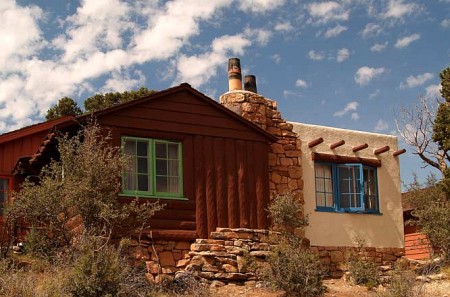
Now you're in high cotton -- one of the fireplace cabins Colter designed for Bright Angel. Photo courtesy of Xanterra
The Bright Angel redevelopment was part of an overall Rim Village design that Colter was working on. Suffice it to say that her plan did not include a crush of vehicles or structures like the Thunderbird or Kachina; we can only imagine how different the south rim experience would be if Colter's vision came to fruition. We do know that Colter placed significant emphasis on history, location, and local materials in her design approach. If a structure -- such as Hermit's Rest -- didn't have a history, she created one and used the design and materials to make it fit. For the design of Bright Angel Lodge, Colter used the common area fireplace concept from the old Bright Angel Hotel as her focal point. For the construction, Colter used not only local materials but at least one original cabin structure in the complex when she preserved Bucky O'Neill's mining cabin and converted it to a duplex.

This is a hand-colored version of the black and white photo shown at the top of this webpage. The Harvey Company used this in various promotional materials for almost three decades
The resulting lodge and cabins have been upgraded, added to and changed over the ensuing years, yet Bright Angel remains an unobtrusive and downright charming series of structures. The main entry area suggests both a western stage stop and forest lodge, while the local stone serves to make the whole thing seem to be a natural part of the landscape and smaller than it actually is, almost invisible by contrast to the structures down the road.

A hand-colored view of the approach to Bright Angel Lodge circa 1935.
Compared to the front elevation, the lobby is much more dramatic. Unfortunately many visitors miss this experience if they aren't staying at the lodge. Most enter Bright Angel Lodge from the rim side, including many people staying at Thunderbird Lodge. Even bus tourists discharged at the front door will walk right around the building to see the Canyon. That is not to suggest that the Bright Angel lobby is more visually stunning than the Grand Canyon...it is just unfortunate that so many people first experience Bright Angel from the "back" side. The lobby is not a massive, cavernous room in the tradition of Old Faithful Inn or Paradise Lodge, but it is a compelling sight that immediately captures the imagination.

Bright Angel Lodge lobby circa 1935. Then as now, Colter's attention to detail and eye for natural beauty creates an imaginary world that conjures a romanticized view of the old west.
The fireplaces Colter designed for the Bright Angel Lodge are under-appreciated masterpieces. The lobby design is more visually captivating; it features massive limestone blocks. The lounge fireplace is the creative one. A geologic study of the Grand Canyon, it employs stone from each layer of the canyon to create a model from rim to river, with each layer approximately to overall scale.
The lodging facility houses 73 guest rooms and cabins. These are decorated in a mix of modern southwestern/mission furnishings with rustic appointments. The rooms are in many ways true to Colter's original designs, so it very much has a historic feel. Everything is of course well maintained and freshly painted, but nothing has been revamped anywhere near the extent of El Tovar -- nor should it be.
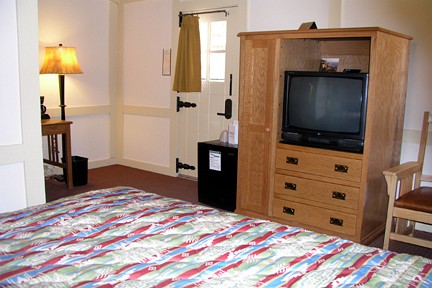
current appearance of a typical cabin interior, photo courtesy of Xanterra

What happens when one of the most influential American architects of the 20th century is asked to re-design a low-brow tourist camp? You get a fine looking bunch of cabins! Photo courtesy of Xanterra.
